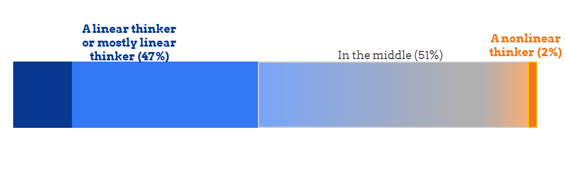We’re all searching for better ways to tap into Shopper insights data to address the “why” in category management — why aren’t we finding it?
In other words, why did they or didn’t they buy? Why is Shopper satisfaction growing or declining? Why are business results trending up or down?
As the Shopper path to purchase becomes more complex and non-linear, so does the analytic pathway that we need to follow to understand the Shopper. Linear thinking that has driven category reviews, assortment and planograms won't help us as we move through massive amounts of more granular data, Shopper Insights and new data sources in this quest for Shopper satisfaction.
In category management, we’ve become much too comfortable with and reliant upon linear thinking – partly because our category management work has become tactical and quantity focused vs strategically focused.
This step-by-step thinking creates a barrier to more strategic decision making because the path to analytics isn’t a straight line, but one that zigs and zags based on what the data says.
So how is our industry doing?
During a recent educational webinar for our students, I polled the more than 150 attendees on what type of thinker they thought they were, and the results were astounding.
Only 2% of primarily category management practitioners rated themselves as nonlinear thinkers! Based on this, I believe that teaching critical thinking is one of the biggest skill development opportunity areas in our industry. And it’s a skill that takes time and practice to fully develop.
Need to continuously improve your knowledge or stay up to date on current issues? Access educational webinars, thought leadership articles, and tons of resources with a monthly or yearly Category Management Membership.
The key to navigating this winding and wiggly path?
Critical thinking, which allows us to analyze and evaluate information to obtain the greatest amount of knowledge from it.
Critical thinking in category management provides the best opportunity to make the most informed decision, and minimizes damages if a misstep does occur because you’ve thoroughly anticipated the implications of your decisions.
The better we are at critical thinking, the easier it is to:
- Identify relevant information,
- Ask the relevant and specific questions, and
- Separate reliable facts from assumptions.
The opportunity? Build your decision making and problem solving skills to become a more critical thinker and begin to find connections between seemingly unrelated thoughts (e.g. different data sources, perspectives as they relate to the Shopper) and then present it in a clear and simple way (through fact-based storytelling).
What is Critical Thinking?
Critical thinking is defined as “the process of conceptualizing, applying, analyzing, synthesizing, and evaluating information to reach an answer or conclusion” (Dictionary.com’s 21st Century Lexicon). Critical thinking is disciplined thinking that is clear, rational, open-minded, and informed by evidence or facts.
What are its outcomes?
To build your critical thinking skills, you need to step out of your comfort zone and look at problems and information from a different perspective. Let yourself go into those areas that make you feel less comfortable and stretch your thinking. This will open doors to new ways of thinking and tackling problems you face.
Critical thinking will allow you to:
- Distinguish between facts and your own assumptions – often we tend to jump to conclusions or explain the unexplainable. If a number can’t be explained, don’t try to explain it. This usually represents an area to investigate more deeply to find the “why” (possibly using Shopper insights).
- Look for missing information - check to see if any premises or vital information is missing – maybe some of those Shopper insights or different perspectives come from alternate data sources. A key point to remember is that no conclusions can be made without premises.
- Expect and initiate change – moving to more critical thinking will help you adapt to change, ensuring your survival in an ever-changing environment.
4 Steps of Critical Thinking
- Ask the right questions.
- Organize your data.
- Evaluate the information.
- Draw conclusions.
When you develop presentations that follow the critical thinking framework you’ll create sound, objective, and logical arguments that persuade your audience.
Using critical thinking skills will ensure that you are prepared for meaningful conversations with business partners.
But this alternate way of thinking requires evaluation of arguments and conclusions before accepting them. It requires examination, questioning, and consideration before a course of action is selected.
Are you a Linear or Non-Linear Thinker?
You don’t have to be either a linear or nonlinear thinker – many of us fall somewhere in the middle. Consider these attributes:
Linear / Vertical Thinkers:
- Your thoughts tend to form a line – one thought leads to the next, and to the next, and so on. The thought process is easy to understand; conclusions are logically sound but not necessarily profound (think of much of the work that is done behind shelving and assortment, where it’s process driven and very tactical).
- Stereotypical Examples: analysts, scientists, accountants
Non-Linear / Critical Thinkers:
- You tend not to list the premises in a normal step-by-step fashion, or you approach a problem in an atypical order. Your thoughts lead to conclusions that may not have otherwise been evident and conclusions are more profound and insightful.
- Stereotypical Examples: artists, designers, creatives
Critical Thinking Quiz
Here’s a simple (and very unscientific) challenge to test your own nonlinear thinking skills.
- If you were alone in a deserted house at night, and there was an oil lamp, a candle and firewood and you only have one match, which would you light first?
- What can you put in a wooden box that would make it lighter? The more of them you put in the lighter it becomes, yet the box stays empty.
- Which side of a cat contains the most hair?
- The 60th and 62nd British Prime Ministers of the UK had the same mother and father, but were not brothers. How do you account for this?
scroll down for answers
-------
-------
-------
-------
-------
-------
-------
-------
-------
-------
Answers to Questions:
- The Match
- Holes (or light)
- The Outside
- He’s the same guy



